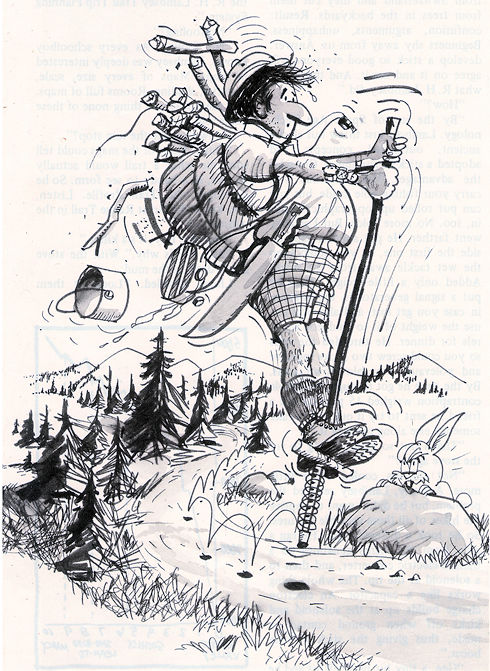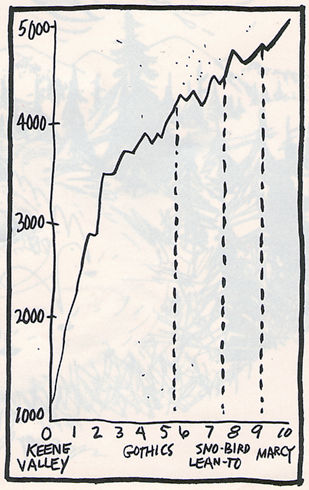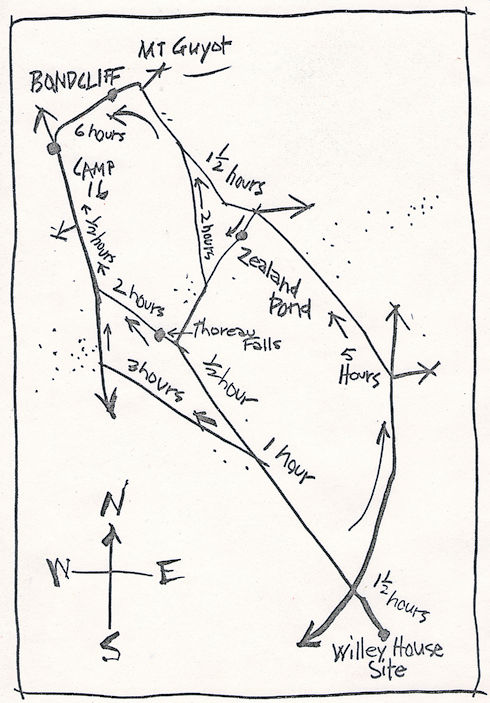The World's Greatest Backpacker

By Walter D. Houck - Wilderness Camping - September-October 1972
Our author is an old trail-hound who hails from the Bronx (for you Westerners and Southerners, that's the outback Borough of NYC). Most important of all, Walter is a close friend and confidante of that greatest of all backpackers - R. S. Lambsey, about whom he has done this article.
Just before this issue went to press, Walter sent us the following late news: "Lambsey, who has sweated and pored over maps in his tiny Portsmouth, New Hampshire apartment for thirty-five years to learn every trail in the Cascades, has now completed his planning. He is presently financing his trip and confidently expects his bingo winnings to provide the price of his bus ticket to Spokane by sometime in 1977, at which time he will actually enter the woods." WJD
The rain beat down steadily as Lloyd and I broke camp one morning last summer. I was pestering a cantankerous camp stove and he was breaking his fingernails on the wet reef knots holding our tarp up. "You know," he said, in a tone of deep frustration, "what we need right now is someone who knows what he's doing."
"Why," I said, "don't you just cut the knot out of the rope?"
"And have the ends unravel until they look like Queen Anne's Lace? No, friend of my youth, I still have a little bit of sense left."
"But not enough to know knots that don't jam when they're wet."
"All those knots are back in the knot book on my bedside table back home. And wouldn't I love to be there right now reading up on them."
"The good backpacker," I intoned, "plans ahead."
"Ow! Another nail! Look at that. Tell me more about what the good backpacker does - as your last words."
"Temper, temper. The good backpacker is humble. In harmony with all creation. Put that rock down! The good packer has many skills. He can tie knots like a Reno preacher. On each of his hands one finger comes to a point, so he can use it as a marlinspike. He has legs nine feet long for crossing the swollen torrents of spring, and his feet are splayed out like a duck's to deal with snow patches. He is of course born with a cast iron stomach and asbestos lips. That's the good backpacker. To be a great backpacker, now, one must have more. The creative genius of an R. H. Lambsey, for instance."
"Of a who?"
"R. H. Lambsey, dolt. Of course you've never heard of him. Like many great men, he is a wee bit eccentric. It happens he has actually never set foot on a trail. But once you have heard of what he has done, you'll see only a small mind could refuse to call him great. Come sit under the tarp and dry out a second and I'll tell you about him."
"Why not? Move over. There, that's better. Now tell me about this candidate of yours for the looney bin."
"The Great Lambsey," I informed him, "is the inventor of many of the items the backpacker of the future will take for granted. Such as the thermos-electric walking stick, the catalytic lightweight trail refrigerator, and the rocket-powered bird snare. Not to mention his greatest discovery, which I'll come to in a moment."
"A thermo-electric walking stick!? Have you been bending over those gas fumes too long? Is this another creation like your friend you swore could telescope his arms to squeeze through between boulders?"
"Friend, how could you ever doubt me? Listen, does this sound like a fable? How Lambsey developed the Walking Stick of Tomorrow?"
"Go on. There's no stopping you anyway once you get started."
"Thank you. As you know, the walking stick has been a real problem for us hikers. Some can't be bothered with the extra weight, while others swear by their sticks as an extra leg for stream crossings, emergency fishing pole, snake protection, and so on. But each person who uses one fights over which is best: bamboo, ashplant, wooden dowel. They import them from Switzerland and they cut them from trees in the backyards. Result: confusion, arguments, unhappiness. Beginners shy away from us. Answer: develop a stick so good everyone will agree on it and use it. And that's just what R. H. Lambsey did."
"How ?"
"By the use of Space Age Technology. Lambsey just threw out all the ancient, outmoded concepts and adopted a stick of aluminum. Consider the advantages. Not only can you carry your fishing pole inside, but you can put rolled up topographical maps in, too. No more folds. But Lambsey went farther. He put another tube inside the first one, so you could keep the wet tackle away from the maps. Added only a little weight. Then he put a signal generator in the bottom, in case you get lost, and also you can use the weight of it to bludgeon squirrels for dinner. He threaded the ends so you could screw two sticks together and pole vault over blowdown areas. By the time he got through, the whole contraption weighed 15 pounds and a friend he sent to try it out had to take someone else along to carry it."
"That's not so great. Going to try the stove again?"
"Not till it's cooled off a little more. Anyway, Lambsey realized the problem, but he didn't want to deprive the hiker of all these valuable features. So he took a different tack. He ran a wire from the signal generator to a thermo-electric converter, and then to a solenoid at the tip. The whole thing works like a capacitor. An electron charge builds up at the solenoid and kicks off when ground contact is made, thus giving the stick a little boost."
"Gee, a tiny bit more effort and he could make the stick walk by itself."
"Patience. He thought of that. But instead, he's developing footpegs for it so you can hop on down the trail."
"Quite a remarkable man, this Lambsey of yours," Lloyd said sarcastically. "Has he done anything else we should know about?"
"Hang on, skeptic. I haven't even mentioned his greatest discovery. Have a minute longer?"
Just then a blast of thunder shook our little camp and echoed off down the canyon until lost in the steady hum of the downpour.
"Maybe just a minute," Lloyd said.
"R. H. Lambsey is the developer of the R. H. Lambsey Trail Trip Planning System."
"No fooling?"
"No fooling. As every schoolboy knows, Lambsey was deeply interested in maps. Maps of every size, scale, material, shading. Rooms full of maps. But there was one thing none of these maps told him."
"How to make the rain stop?"
"Quiet. None of the maps could tell someone what a trail would actually be like, in a handy to see form. So he developed the Trail Profile. Listen, you know the Great Range Trail in the Adirondacks?"

"Sure do. Boy, it's a killer."
"And here's why." With the stove key, I drew in the mud:
Lloyd whistled. "Look at them grades. No wonder I crawl the last mile. You could even use these Profiles to compare trails. Too bad it doesn't tell you anything about directions."
"Lambsey is way ahead of you. The Profile is only the first step. Then relying on the standard formula of 2 and 1/2 miles an hour and 1 hour for every 1000 feet climbing, he makes a Trail Schematic. You know how hard it is to figure out alternate routes, by the time you figure out the extra time it takes to climb. Take the trails around the Zealand Ridge in the White Mountains; you don't know if it's quicker to go around or up and over, or how much you can put in a day. Well, with the Schematic you do. Look:"
"You can see," I continued, "that if you're in a hurry to get to Camp 16 from Willey House you can do it in 5 and 1/2 hours. The real scenic way will take 14 hours, but you can combine most of the scenery with a lot of speed by taking the cut-off at Zealand Pond through Thoreau Falls. That gives you a total of about 9 hours."
Lloyd was unconvinced. "But suppose I want to go the other way, going east out of Camp 16? Then all the climbing time is different, even though the miles are the same."

"You're a hard man to please. Make two maps. Or put the time of one direction above the trail-line, and for the opposite direction below the trail-line. Or you could do what R. H. Lambsey himself did."
"Of course I'll follow in the footsteps of the Great Lambsey. What'd he do?"
"He put the whole shebang, all the factors and everything, including weather which you didn't even mention though it makes a big difference, and fed it all into the computer!"
"He didn't!"
"Yup. Weather reports, trail profiles, number of other hikers on the trail, a scenery factor, right into the machine. And he found the perfect trail."
"This is getting interesting. Tell me more."
"Patience. Rome wasn't built in a day. He had problems. He found the trail, all right, but he made the mistake of telling just one friend about it. Before you could say Wilderness Camping, backpackers from five states showed up, the trail was announced on the radio, it was paved, hotdog stands set up every half mile, with a ranger at trailhead issuing permits.
Lambsey learned his lesson. For his next walk, he's set up all-new data. He's matched a stormy weekend with a trail which is being used as a logging skid, and is also scheduled for simultaneous hikes by the Sierra Club, the Friends of the Wilderness, the Boy Scouts, and the Cosa Nostra. And here's what he's doing. First, he's already organized a stock raid that's forced the lumber company to diversify into plastics. Next, he's going to set up tables with petitions at the trail-head. The Sierra Club people will be so busy signing that they'll never make it to the first lean-to. Next, he's having rare orchids flown up from Brazil and planted along the trail. They'll keep the naturalists occupied. The Boy Scouts and the Cosa Nostra are no problem. Once they see each other, they'll shoot it out, like they always do; the rising gunsmoke will break up the cloud cover, and R. H. Lambsey will have a dry, clear trail to himself at last. So you see, there's hope. And here come's the sun. Come on, let's roll."